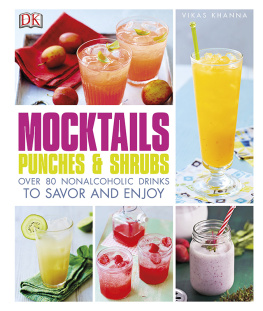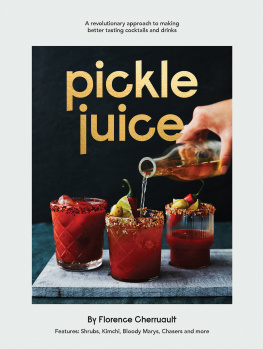

PHOTO CREDITS
All photographs by Jennifer Hess unless otherwise stated below:
: Bill Sallans, used with permission from Liber & Co.
DEDICATION
To Jennifer, Julian, and Mirabelle

Shrub is a colonial-day drink whose name is derived from the Arabic word sharab, to drink. It is a concentrated syrup made from fruit, vinegar, and sugar that is traditionally mixed with water to create a refreshing drink that is simultaneously tart and sweet. In the nineteenth-century, the drink was often spiked with brandy or rum.
Entry in The Ark of Taste,
Slow Food Foundation
CONTENTS
Please bookmark your page before following links.

The word shrub calls to mind a short, stemmy, woody plant, similar to a bush but maybe even a bit bushier. It also refers to a delicious vinegar-based syrup that makes any drinkalcoholic or notmore refreshing. Thats the shrub Im talking about.
I remember the first time I had a shrub. I was in New Orleans for Tales of the Cocktail, in July 2008. Tales of the Cocktail is a cocktail festival held in the French Quarter. It attracts bartenders, distillers, brand representatives, writers, and the general public for five days of seminars, dinners, competitions, tastings, and product launches.
Bartenders around the country were just beginning to rediscover the shrub, and that day I tasted a cocktail by a Chicago bartender named Bridget Albert. Albert is the author of Market-Fresh Mixology , and she holds the position of director of mixology for Southern Wine & Spirits of Illinois. Her drink featured cachaa, a Brazilian liquor made from sugarcane juice thats somewhat similar to rum. She also used raspberry shrub, lime juice, and ginger ale. The drink was balanced and refreshing, with no single ingredient taking over. I could taste the cachaa, the fruit, and the tang of the vinegar, but they were harmonious. And since I had just walked into the hotel from a blistering New Orleans summer day, the drink was also the most refreshing thing I had tasted all day. I kept going back for more.
It turns out that vinegar is incredibly good at quenching your thirst when its hot out. Research shows that sour-tasting beveragessuch as vinegar and lemonadeare better at stimulating salivation than are other drinks. A wet mouth helps you feel hydrated even after youre done drinking.
Salivation not only makes you feel hydrated, it stimulates the appetite. Salivation usually indicates to your stomach that food is forthcoming, and therefore it primes your digestive juices to get ready to work. Shrubs are a perfect cocktail to prepare you for a night of fine dining.
When I got home, I had to re-create the drink because I knew my wife would love it. Unfortunately, raspberry season had ended in my area, and I couldnt reproduce the raspberry shrub. However, I was able to find blueberries and gooseberries, so I cooked up my version using those ingredients.
I was rightmy wife loved it, and we both fell in love with shrubs.
From that point on, I made them frequently. We drank them in cocktails, we drank them with vermouth or sherry, and we drank them without alcohol, just topped with soda or seltzer. During the summer of 2010, I went on a shrub-making frenzy. I made shrubs out of every type of berry I could find, plus peaches, apricots, nectarines, and cherries. I had so many shrubs in the fridge at any given time that it was hard to fit anything else in there.
My wife would open the door and a bottle of shrub would nearly tumble out onto the floor. Shed shoot dirty looks and sardonic comments my way. But I had the last laugh. In 2011, we found out we were expecting our first child, and those shrubs helped sustain her through her pregnancy when she couldnt drink alcohol.
One of the joys of shrubs is that theyre both an adult beverage and a soft drink at the same time. The blend of fruit and tartness is challenging for a lot of children to appreciate, so shrubs tend to appeal more to adults than to kids (although if your kids enjoy shrubs, youve got the coolest kids in the neighborhood). But just because shrubs are adult doesnt mean you need to serve them in a boozy way for them to be tasty. The balance of sweet and tart is sophisticated and complex enough that theyre wonderful with just soda.

We in the United States have a rich food heritage, and a history of creatively cultivating plants and animals for food purposes. But that culture is shrinking, and many of the foods our grandparents and their grandparents ate are disappearing, either through biological extinction or cultural neglect. Since 1996, the organization Slow Food has been working to develop an Ark of Taste, a catalogue of heritage foods that are in danger of extinction. The shrub is catalogued in this collection.
The Ark of Taste aims to save these foods and call attention to their plight. A food might appear on the Ark of Taste because its an endangered species, as are certain plants and animals, or it may simply be at risk of being forgotten. Shrub falls into the latter category. The ingredients are plentiful, so theres no risk that shrub is in danger biologically. In fact, the rise of shrubs in popular culture has never been felt more keenly than it is today.
Eric Felten provided the spark in July 2006, writing about Independence Day barbecue beverages for the Wall Street Journal. He noted that one of the very few places you could find shrub on a menu was City Tavern in Philadelphia, where its served with rum, brandy, or champagne. He discussed the thirst-quenching potential for shrubby drinks at Fourth of July cookouts, and provided a recipe. But then he concluded, why bother when Pennsylvanias Tait Farm makes luscious Shrub syrups in a variety of flavors, using their own fresh fruit vinegars? (More on Tait Farm to come.)
Feltens cocktail column was always intelligent, well informed, and witty. As the craft-cocktail movement gathered steam in the first decade of this millennium, his column was pored over by cocktail enthusiasts, writers, and bartenders. So when the idea of shrubs arose in his column, people who study cocktails jumped on it. In 2007 and 2008, shrubs started to gain some steam as ingredients for cocktails, appearing in blog posts, in beverage and bar-industry magazines, and on cocktail menus.

Vinegar drinks are more than just a cocktail trend, however. Theyre also common in Southeast Asian cuisine. Andy Ricker is the chef and owner of Pok Pok, a Thai-influenced restaurant with locations in Portland, Oregon, and New York City. Ricker put drinking vinegars on his menu when he opened his eatery. The vinegars were so popular that he now sells bottled versions of them, called Som. The Som line of drinking vinegars includes apple, ginger, honey, pineapple, pomegranate, raspberry, tamarind, and Thai basil flavors. Pok Poks cocktail menu includes a variety of drinks that feature the Som vinegars.

Next page














